|
|
|
Sort Order |
|
|
|
Items / Page
|
|
|
|
|
|
|
| Srl | Item |
| 1 |
ID:
191354
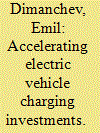

|
|
|
|
|
| Summary/Abstract |
Replacing conventional cars and trucks with battery electric vehicles requires a rapid expansion of fast-charging infrastructure. However, private sector charging infrastructure investments are delayed by unfavorable project economics and uncertainty in future demand. Prior research has addressed the former using standard net present value (NPV) methods, but neglected the latter. To address this gap, this paper introduces a real options model of charging investments, which quantifies the option value of delaying investment under uncertainty. We use this model to assess the implications of optionality in a representative case. Our analysis provides indicative estimates of how investment timing is impacted by alternative policy options: grants, long-term contracts, demand charge re-design, and Zero Emission Vehicle standards. We estimate that if grant subsidies are informed by a traditional NPV analysis, firms would delay investing by more than 5 years. Perhaps surprisingly, even low levels of risk incentivize long delays. We find that policies targeting optionality are substantially more cost-effective than the traditionally used grants. Specifically, we calculate that long-term contracts for differences can trigger immediate investments at a cost 68% lower than grants. A simpler but relatively cost-effective alternative is to introduce a phase-out schedule for grants to discourage investment delays.
|
|
|
|
|
|
|
|
|
|
|
|
|
|
|
|
| 2 |
ID:
116962


|
|
|
|
|
| Publication |
2012.
|
| Summary/Abstract |
The agriculture sector's contribution to energy production is a central issue in ongoing policy debates, and one of the central elements of the development of Bioeconomy sector. The Common Agricultural Policy (CAP) is one of the main determinants of the different farm strategies of European farmers. The CAP is now undergoing a thorough revision process which necessarily includes a debate of the role of the policy in rural areas and the effectiveness of the various CAP policy mechanisms. The objective of this paper is to assess the impact of alternative CAP scenarios in the light of the possible changes in 2013 and the willingness to adopt energy plants for energy crops in the Province of Bologna (Italy). This is pursued using both survey information and farm-household mathematical programming models, hence using stated intentions and simulated profitability to analyse the adopt of new technologies for energy production. The results underscore the relevance of the CAP scenarios in altering intentions with regard to the adoption of energy production and the relevant effect of uncertainty in delaying the diffusion of energy production systems.
|
|
|
|
|
|
|
|
|
|
|
|
|
|
|
|
| 3 |
ID:
101411


|
|
|
|
|
| Publication |
2011.
|
| Summary/Abstract |
This paper is to develop a modified Tobin's q evaluation method which successfully combines the evaluation criteria of the traditional Tobin's q and the real options. This study provides flexible thinking for decision making criteria. That is, it clearly provides decision-makers with a reference in choosing enter or exit strategies, such as quantitative indicators references. The proposed model introduces two variables stochastic process in continuous time and explores the impact of the occurrence of unexpected events on the project value, so that, it can more authentically response to the project value. The studied issue deals with the firms that have not established energy-saving equipment yet. It attempts to figure out the optimal timing to adopt an energy-saving investment project when it is beneficial and the optimal timing to terminate it when the continuous operation of that business is unprofitable. The future discounted benefit-cost ratio, Q, follows the geometric Brownian motion with the Poisson jump process and the replacement of investment equipment. Except for the evaluation of energy-saving equipment investment project, the proposed model can be applied to other related project evaluation issues, such as energy-saving, CO2 emission reduction, or general investment projects.
|
|
|
|
|
|
|
|
|
|
|
|
|
|
|
|
| 4 |
ID:
189401


|
|
|
|
|
| Summary/Abstract |
Augustine weapons systems are proposed as a new class of investment good. They have distinctive economic characteristics (technology intensive, high and rising unit costs, and declining volumes) leading to extensive changes in armed forces’ arsenals including the progressive replacement of military bulk with ever-smaller volumes of increasingly complex, capable, but also expensive weapons systems. While much has been written about their costs, there remain gaps in our understanding of their investment rationale and the modus operandi of their procurement. We distinguish between incremental and transformative Augustine weapons systems and discuss their investment rationale. We show that further understanding of Augustine weapons systems is obtained by using Lancaster’s model of product characteristics and the real investment options framework. Some civilian parallels are also discussed.
|
|
|
|
|
|
|
|
|
|
|
|
|
|
|
|
| 5 |
ID:
162332


|
|
|
|
|
| Summary/Abstract |
An investigation of Poisson type policy jumps on biodiesel investment considers the theory of investment under uncertainty. The analysis studies the probability of implementing a policy if it is not in effect and the probability of withdrawal if it is in effect. An application models the policy-switching regime of the discontinuous U.S. federal tax credit of $1.00 per gallon on biodiesel. Results support that time inconsistent government policies do lead to market uncertainty. The analysis reveals a pronounced negative impact on decisions to invest in a biodiesel refinery. Results do indicate a consistent policy-switching regime may not be that disruptive to the emerging biodiesel industry. It is policy uncertainty that drives the option-pricing thresholds and a consistent policy switching does not increase the uncertainty.
|
|
|
|
|
|
|
|
|
|
|
|
|
|
|
|
| 6 |
ID:
127911


|
|
|
|
|
| Publication |
2014.
|
| Summary/Abstract |
Wind energy has been negotiated in Brazil's regulated market through auctions organized by the government. Bilateral negotiations in the free market have been scarce. In 2011 wind farms were allowed to bid in 'A minus 5 (A?5)' auctions, for energy with first delivery date 5 years ahead. This new design was expected to stimulate negotiations in the free market, as the 20-year contract in the regulated market eases financing while the 5-year grace period grants wind farms the option to sell whatever energy is generated beforehand in the free market. We modeled bidders' price decision in A?5 auctions as Real Options and concluded that given the low prices averaging USD 50/MW h, winners are tempted to defer investment, expecting more favorable equipment and energy prices, or a better knowledge of the wind site. Construction is likely to begin in 2-3 years, with little time left for the free market. Bidders that consider the option of eventually abandoning the project are more price competitive, increasing chances that some wind farms will never materialize. Therefore, this attempt to foster the free market may not pay-off and, moreover, it may have the unfavorable effect of turning Brazil's energy expansion planning a more difficult task.
|
|
|
|
|
|
|
|
|
|
|
|
|
|
|
|
| 7 |
ID:
110389
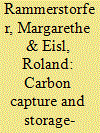

|
|
|
|
|
| Publication |
2011.
|
| Summary/Abstract |
The following article deals with real options modeling for investing into carbon capture and storage technologies. Herein, we derive two separate models. The first model incorporates a constant convenience yield and dividend for the investment project. In the second model, the convenience yield is allowed to follow a mean reverting process which seems to be more realistic, but also increases the model's complexity. Both frameworks are to be solved numerically. Therefore, we calibrate our model with respect to empirical data and provide insights into the models' sensitivity toward the chosen parameter values. We found that given the recently observable prices for carbon dioxide, an investment into C O2-storage facilities is not profitable.
|
|
|
|
|
|
|
|
|
|
|
|
|
|
|
|
| 8 |
ID:
090812
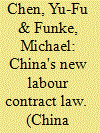

|
|
|
|
|
| Publication |
2009.
|
| Summary/Abstract |
In January 2008, China adopted a new labour contract law. This new law represents the most significant reform to the legislation on employment relations in mainland China in more than a decade. The paper provides a theoretical framework on the inter-linkages between labour market regulation, option value and the choice and timing of employment. All in all, the paper demonstrates that the Labour Contract Law in its own right will have only small impacts upon employment in the fast-growing Chinese economy. Rather, possibly induced increasing unit labour costs may adversely affect employment
|
|
|
|
|
|
|
|
|
|
|
|
|
|
|
|
| 9 |
ID:
188571
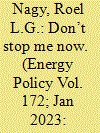

|
|
|
|
|
| Summary/Abstract |
Once a subsidy scheme is close to reaching its goal or loses political support, it may be terminated. An important question for policy makers is how to minimize the negative impact of the risk of subsidy termination on industrial investment. We assume the social planner aims to increase capacity and welfare and uses a subsidy, which has an uncertain lifetime, for the purpose. We examine a monopolist supplying an uncertain demand, faced with the option to expand capacity by irreversibly investing in small increments. We find that the firm installs capacity expansions sooner and, consequently, installs a larger capacity than a firm without a subsidy. A firm’s total investment during the subsidy’s lifetime increases with both the subsidy size and the likelihood of subsidy withdrawal. However, this happens at the cost of less investment directly after the subsidy has been retracted. The optimal subsidy size strongly depends on the point in time at which the social planner aims to maximize the welfare — the further into the future, the larger the welfare optimal subsidy. Furthermore, the welfare optimal subsidy size strongly depends on the social planner’s discretion over adjustments to the subsidy size.
|
|
|
|
|
|
|
|
|
|
|
|
|
|
|
|
| 10 |
ID:
150925


|
|
|
|
|
| Summary/Abstract |
This study models fundamental features of current and prospective policies encouraging adoption of residential photovoltaic (PV) systems. A key finding is that time-of-day (ToD) pricing can enhance or worsen the economics of PV systems. Moreover, increased responsiveness of electricity demand to its price diminishes the effectiveness of ToD pricing in the absence of net metering, but does not affect it otherwise. An application to plausible conditions in the State of Indiana, USA, shows that current policies are unlikely to trigger adoption by a risk-neutral forward-looking residential customer. However, adoption of PV systems can be induced if the Federal Tax Credit is increased to cover 48% of capital cost (instead of the current 30%), which could imply a cost to the Federal Government of about $0.95/kW of installed capacity depending on the panel’s size. We demonstrate that implementation of ToD pricing can trigger adoption under a range of on- and off-peak price combinations. But our analysis also shows that the cost-effectiveness of ToD pricing is enhanced at higher ratios of on-peak to off-peak prices.
|
|
|
|
|
|
|
|
|
|
|
|
|
|
|
|
| 11 |
ID:
181441
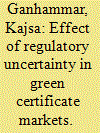

|
|
|
|
|
| Summary/Abstract |
European Commission favours market-based support policies, such as markets for tradable green certificates, to promote renewable energy. Meanwhile, these instruments have received critique for exposing investors to large price risk as the level of support is determined by the market price of certificates. Using a two-step procedure, this study builds upon the work of Fagiani and Hakvoort (2014) by firstly examining how regulatory interventions in the Swedish-Norwegian certificate market affect price volatility, focusing particularly on the period after Norway joined in 2012. The results show that interventions in the market exacerbate price risk by resulting in regimes of increased volatility. They indicate that, contrary to policymakers expectation, prices did not stabilise after the market integration with Norway. Employing a real options approach, the study further proceeds to demonstrate that price risk increases the threshold for immediate development of Swedish wind power projects; a one standard deviation increase in certificate price volatility is estimated to reduce the probability of project development by 12%. These findings illustrate that regulatory uncertainty in terms of high price volatility disrupts the investment climate in certificate markets, ultimately affecting cost-effectiveness of such policy.
|
|
|
|
|
|
|
|
|
|
|
|
|
|
|
|
| 12 |
ID:
094223


|
|
|
|
|
| Publication |
2010.
|
| Summary/Abstract |
This paper presents an improved decision model based on the real options approach presented by for the firms that have not yet established energy-saving equipment under the entry and exit strategies. Furthermore, the proposed model takes account of the inevitable equipment renewal and the occurrence of unexpected events under the Poisson jump process. The timing for terminating an investment when continuous operations of that business are unprofitable is also explored to realize the optimal timing of implementing the energy-saving strategy. The future discounted benefit B follows the geometric Brownian motion with the Poisson jump process and the replacement of investment equipment. A numerical analysis is followed by a sensitivity study of various parameters to better realize their impacts on the entry and exit thresholds. The results show that for the jump case, the higher probability of occurrence of unfavorable events will result in a higher entry threshold and lower exit threshold. Investors are forced to request higher benefit thresholds to cover the higher probability of losses brought by unfavorable events.
|
|
|
|
|
|
|
|
|
|
|
|
|
|
|
|
| 13 |
ID:
111335


|
|
|
|
|
| Publication |
2012.
|
| Summary/Abstract |
This paper is focused on the analysis of spillover benefits of the ongoing R&D programme on thermonuclear fusion technology. The spillover effects are understood here as positive externalities of publicly funded R&D, demonstration and deployment (RDDD) activities that may be revealed at the companies' level in the form of newly created knowledge stock; development of innovative products/processes with broader market applications; strengthening of R&D, manufacturing and marketing capabilities; etc. An integrated compound real options model is proposed that allows to estimate the strategic net social present value of fusion RDDD programme taking into account the different types of spillover benefits along with the hidden real options value arising due to uncertainty and managerial flexibility. It was found that the value of spillover effects, modelled as "expansion option", could represent a significant proportion of the overall socio-economic value of fusion RDDD programme (nearly 20%). This paper clearly demonstrates that, besides a high-level mission to assure sustainable energy supply, fusion RDDD programme may yield substantial net socio-economic benefits that may be at least two times higher compared to the expected RD&D costs, and hence the pursuit of even more ambitious programme is economically justified.
|
|
|
|
|
|
|
|
|
|
|
|
|
|
|
|
| 14 |
ID:
094232


|
|
|
|
|
| Publication |
2010.
|
| Summary/Abstract |
This paper investigates the valuation of a replacement project of nuclear power plants under the deregulated electricity market. The replacement project consists of two components: the decision to decommission an existing plant and the decision to construct a new plant. In the replacement project, the decommissioning decision should be made considering not only the profitability of the existing plant but also the profitability and costs of the construction of the new plant. Real options theory is used to determine the optimal timing of the decommissioning and construction. In order to examine the effect of decommissioning time and decision making one, we consider a time-lag for these decision making times. We show the dependence of the replacement project value on uncertainty and time-lag.
|
|
|
|
|
|
|
|
|
|
|
|
|
|
|
|
| 15 |
ID:
150066


|
|
|
|
|
| Summary/Abstract |
Classical deterministic models applied to investment valuation in distribution networks may not be adequate for a range of real-world decision-making scenarios as they effectively ignore the uncertainty found in the most important variables driving network planning (e.g., load growth). As greater uncertainty is expected from growing distributed energy resources in distribution networks, there is an increasing risk of investing in too much or too little network capacity and hence causing the stranding and inefficient use of network assets; these costs are then passed on to the end-user. An alternative emerging solution in the context of smart grid development is to release untapped network capacity through Demand-Side Response (DSR). However, to date there is no approach able to quantify the value of ‘smart’ DSR solutions against ‘conventional’ asset-heavy investments. On these premises, this paper presents a general real options framework and a novel probabilistic tool for the economic assessment of DSR for smart distribution network planning under uncertainty, which allows the modeling and comparison of multiple investment strategies, including DSR and capacity reinforcements, based on different cost and risk metrics.
|
|
|
|
|
|
|
|
|
|
|
|
|
|
|
|
| 16 |
ID:
162340


|
|
|
|
|
| Summary/Abstract |
In order to encourage investments in the most cost-effective renewable energy projects, Norway and Sweden have implemented a joint green certificate subsidy system, where the certificates are traded on a common market. The policies applied in the two countries, however, are not identical and differ most notably by the deadlines for receiving the subsidy. From the policy perspective, the important question is how these differences affect investment behavior in the renewable sector. This paper investigates the impact of the green certificate subsidy scheme on the value of renewable energy investments from the perspective of both Norwegian and Swedish investors based on a wind energy case study. We find that the impact of the policy is greatest when the distinctive Norwegian investment deadline is approaching, making investment optimal for the Norwegian investor for a larger range of prices. The Swedish investor, having no deadline to meet, will be more reluctant to investing. Furthermore, we find that the possibility of a collapse in the green certificate price reduces the values of the investment options. Being able to learn about the likelihood of such a price collapse leads to a small increase in the values of the options.
|
|
|
|
|
|
|
|
|
|
|
|
|
|
|
|
| 17 |
ID:
162335


|
|
|
|
|
| Summary/Abstract |
In order to encourage investments in the most cost-effective renewable energy projects, Norway and Sweden have implemented a joint green certificate subsidy system, where the certificates are traded on a common market. The policies applied in the two countries, however, are not identical and differ most notably by the deadlines for receiving the subsidy. From the policy perspective, the important question is how these differences affect investment behavior in the renewable sector. This paper investigates the impact of the green certificate subsidy scheme on the value of renewable energy investments from the perspective of both Norwegian and Swedish investors based on a wind energy case study. We find that the impact of the policy is greatest when the distinctive Norwegian investment deadline is approaching, making investment optimal for the Norwegian investor for a larger range of prices. The Swedish investor, having no deadline to meet, will be more reluctant to investing. Furthermore, we find that the possibility of a collapse in the green certificate price reduces the values of the investment options. Being able to learn about the likelihood of such a price collapse leads to a small increase in the values of the options.
|
|
|
|
|
|
|
|
|
|
|
|
|
|
|
|
| 18 |
ID:
171380


|
|
|
|
|
| Summary/Abstract |
In actual energy-only markets, the high volatility of power prices affects the expected returns of generators. When dealing with irreversibility under uncertainty, deferring decisions to commit in new power plants, waiting for better information, is therefore a rational approach. Theoretical and empirical evidence suggests that such investment pattern determines the occurrence of construction cycles, which strongly compromise supply security. In order to supplement generators' revenues, several remuneration mechanisms have been devised over past years. Along this line, this work addresses the long-run dynamics of capacity adequacy and market efficiency with both a price-based and a quantity-based capacity remuneration policy. For that purpose, a recently-developed, stochastic simulation model is used as a benchmark. Hence, the optimal postponement of generation investment decisions is integrated into a long-run power market model by formulating the decision-making problem in the framework of Real Options Analysis. Results suggest that policymakers may exchange supply security (effectiveness) for energy prices to be paid by consumers (efficiency) when designing and implementing capacity remuneration mechanisms. By doing so, this article contributes to the ongoing debate regarding the design of incentive policies and efficient power markets by considering the microeconomics of investors’ decision-making under irreversibility and uncertainty.
|
|
|
|
|
|
|
|
|
|
|
|
|
|
|
|
| 19 |
ID:
177094
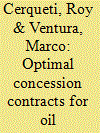

|
|
|
|
|
| Summary/Abstract |
This paper studies the relationship between a government and private companies for the exploitation of an oilfield by means of concession-like contracts, i.e. concessions and Production Sharing Agreements. At this aim, we develop and solve a dynamic stochastic optimization problem in a real option framework. The model takes into account crucial as well as actual features of the real world, such as: the twofold goal of governments who must mediate between social interests and revenue maximization from concessions; the incentive for the private party to ”over exploit” natural resources and uncertainty over future payoffs. The results obtained can help policy makers in pursuing the delicate task of setting the ”right” terms of concession-like contracts, meaning that policy makers can have at least a benchmark to start interacting with private parties. This phase is particularly difficult for a number of reasons, such as the need to trade contrasting interests off, high risk of corruption and the fact that negotiations are made difficult by the high level of uncertainty due to incomplete or even faulty information.
|
|
|
|
|
|
|
|
|
|
|
|
|
|
|
|
| 20 |
ID:
150059


|
|
|
|
|
| Summary/Abstract |
The feed-in tariff policy is widely used to promote the development of renewable energy. China also adopts feed-in tariff policy to attract greater investment in solar photovoltaic power generation. This study employs real options method to assess the optimal levels of feed-in tariffs in 30 provinces of China. The uncertainties in CO2 price and investment cost are considered. A method that integrates the backward dynamic programming algorithm and Least-Squares Monte Carlo method is used to solve the model. The results demonstrate that the feed-in tariffs of 30 provinces range from 0.68 RMB/kWh to 1.71 RMB/kWh, and the average level is 1.01 RMB/kWh. On this basis, we find that the levels of sub-regional feed-in tariff announced in 2013 are no longer appropriate and should be adjusted as soon as possible. We have also identified the implications of technological progress and carbon emission trading schemes, as well as the importance of strengthening electricity transmission. It has been suggested that the Chinese government takes diverse measures, including increasing research and development investment, establishing and improving a nationwide carbon emission trading scheme and accelerating the construction of electricity-transmission infrastructure, to reduce the required feed-in tariff and promote the development of solar photovoltaic power generation.
|
|
|
|
|
|
|
|
|
|
|
|
|
|
|
|
|
|
|
|
|